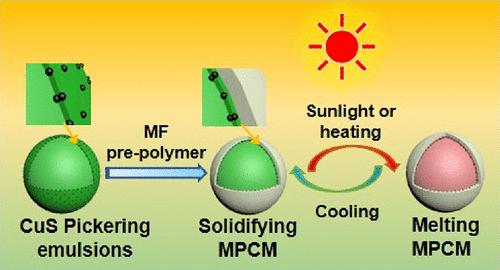当前位置:
X-MOL 学术
›
ACS Appl. Nano Mater.
›
论文详情
Our official English website, www.x-mol.net, welcomes your
feedback! (Note: you will need to create a separate account there.)
CuS Nanoparticle-Based Microcapsules for Solar-Induced Phase-Change Energy Storage
ACS Applied Nano Materials ( IF 5.3 ) Pub Date : 2022-09-12 , DOI: 10.1021/acsanm.2c02804 Mengyu Du 1 , Xufeng Yu 1 , Zhaoxia Zhang 1 , Min Shao 2 , Lan Zhou 2, 3 , Guocheng Zhu 2, 3 , Jiri Militky 4 , Dana Kremenakova 4 , Guoqing Zhang 1, 3
ACS Applied Nano Materials ( IF 5.3 ) Pub Date : 2022-09-12 , DOI: 10.1021/acsanm.2c02804 Mengyu Du 1 , Xufeng Yu 1 , Zhaoxia Zhang 1 , Min Shao 2 , Lan Zhou 2, 3 , Guocheng Zhu 2, 3 , Jiri Militky 4 , Dana Kremenakova 4 , Guoqing Zhang 1, 3
Affiliation

|
Phase-change microcapsules with photothermal conversion capabilities have been the focus of research in the energy storage field. In this study, a route is developed to prepare photothermal conversion and phase-change energy storage microcapsules by copper sulfide-stabilized Pickering emulsion with dodecanol tetradecyl ester as the phase-change material (PCM) and melamine formaldehyde resin (MF) as a shell. Spherical CuS particles with a diameter of approximately 10 nm are first synthesized by a facile hydrothermal reaction. The obtained CuS nanoparticles are used not only as a stabilizer but also as a photothermal conversion material in the preparation of the microcapsules. Then, the PCM microcapsules are prepared by a one-pot interfacial polymerization route and showed a well-defined core–shell structure with an average size of approximately 7 μm. The synthesized microcapsules have a latent heat of up to 180.3 J/g and an encapsulation efficiency of 81.36%. Meanwhile, the thermal conductivity of the microcapsules increased by 115–254% compared to the core material due to the hybrid shell filled with CuS nanoparticles. The photothermal conversion capacity of the synthesized microcapsules is measured and calculated to be up to 85.6%, achieving light-induced phase change and further inducing the passive thermal cycle. This study provides a potential candidate for the application of light-induced energy storage microcapsules in fabric insulation, solar hot water heating systems, and solar thermal power systems.
中文翻译:

用于太阳能相变储能的 CuS 纳米颗粒基微胶囊
具有光热转换能力的相变微胶囊一直是储能领域的研究热点。本研究以十二烷醇十四烷基酯为相变材料(PCM),三聚氰胺甲醛树脂(MF)为壳,开发了硫化铜稳定的Pickering乳液制备光热转换相变储能微胶囊的路线。首先通过简便的水热反应合成直径约为 10 nm 的球形 CuS 颗粒。得到的 CuS 纳米粒子不仅可用作稳定剂,还可用作制备微胶囊的光热转换材料。然后,PCM 微胶囊通过一锅界面聚合途径制备,显示出明确的核壳结构,平均尺寸约为 7 μm。合成的微胶囊具有高达180.3 J/g的潜热和81.36%的封装效率。同时,由于填充有 CuS 纳米颗粒的混合壳,微胶囊的热导率比核材料增加了 115-254%。合成的微胶囊的光热转换能力经测量计算可达85.6%,实现了光致相变,进一步诱导了被动热循环。该研究为光致储能微胶囊在织物绝缘、太阳能热水加热系统和太阳能热电系统中的应用提供了潜在的候选者。合成的微胶囊具有高达180.3 J/g的潜热和81.36%的封装效率。同时,由于填充有 CuS 纳米颗粒的混合壳,微胶囊的热导率比核材料增加了 115-254%。合成的微胶囊的光热转换能力经测量计算可达85.6%,实现了光致相变,进一步诱导了被动热循环。该研究为光致储能微胶囊在织物绝缘、太阳能热水加热系统和太阳能热电系统中的应用提供了潜在的候选者。合成的微胶囊具有高达180.3 J/g的潜热和81.36%的封装效率。同时,由于填充有 CuS 纳米颗粒的混合壳,微胶囊的热导率比核材料增加了 115-254%。合成的微胶囊的光热转换能力经测量计算可达85.6%,实现了光致相变,进一步诱导了被动热循环。该研究为光致储能微胶囊在织物绝缘、太阳能热水加热系统和太阳能热电系统中的应用提供了潜在的候选者。由于填充了 CuS 纳米颗粒的混合壳,微胶囊的热导率与核心材料相比增加了 115-254%。合成的微胶囊的光热转换能力经测量计算可达85.6%,实现了光致相变,进一步诱导了被动热循环。该研究为光致储能微胶囊在织物绝缘、太阳能热水加热系统和太阳能热电系统中的应用提供了潜在的候选者。由于填充了 CuS 纳米颗粒的混合壳,微胶囊的热导率与核心材料相比增加了 115-254%。合成的微胶囊的光热转换能力经测量计算可达85.6%,实现了光致相变,进一步诱导了被动热循环。该研究为光致储能微胶囊在织物绝缘、太阳能热水加热系统和太阳能热电系统中的应用提供了潜在的候选者。
更新日期:2022-09-12
中文翻译:

用于太阳能相变储能的 CuS 纳米颗粒基微胶囊
具有光热转换能力的相变微胶囊一直是储能领域的研究热点。本研究以十二烷醇十四烷基酯为相变材料(PCM),三聚氰胺甲醛树脂(MF)为壳,开发了硫化铜稳定的Pickering乳液制备光热转换相变储能微胶囊的路线。首先通过简便的水热反应合成直径约为 10 nm 的球形 CuS 颗粒。得到的 CuS 纳米粒子不仅可用作稳定剂,还可用作制备微胶囊的光热转换材料。然后,PCM 微胶囊通过一锅界面聚合途径制备,显示出明确的核壳结构,平均尺寸约为 7 μm。合成的微胶囊具有高达180.3 J/g的潜热和81.36%的封装效率。同时,由于填充有 CuS 纳米颗粒的混合壳,微胶囊的热导率比核材料增加了 115-254%。合成的微胶囊的光热转换能力经测量计算可达85.6%,实现了光致相变,进一步诱导了被动热循环。该研究为光致储能微胶囊在织物绝缘、太阳能热水加热系统和太阳能热电系统中的应用提供了潜在的候选者。合成的微胶囊具有高达180.3 J/g的潜热和81.36%的封装效率。同时,由于填充有 CuS 纳米颗粒的混合壳,微胶囊的热导率比核材料增加了 115-254%。合成的微胶囊的光热转换能力经测量计算可达85.6%,实现了光致相变,进一步诱导了被动热循环。该研究为光致储能微胶囊在织物绝缘、太阳能热水加热系统和太阳能热电系统中的应用提供了潜在的候选者。合成的微胶囊具有高达180.3 J/g的潜热和81.36%的封装效率。同时,由于填充有 CuS 纳米颗粒的混合壳,微胶囊的热导率比核材料增加了 115-254%。合成的微胶囊的光热转换能力经测量计算可达85.6%,实现了光致相变,进一步诱导了被动热循环。该研究为光致储能微胶囊在织物绝缘、太阳能热水加热系统和太阳能热电系统中的应用提供了潜在的候选者。由于填充了 CuS 纳米颗粒的混合壳,微胶囊的热导率与核心材料相比增加了 115-254%。合成的微胶囊的光热转换能力经测量计算可达85.6%,实现了光致相变,进一步诱导了被动热循环。该研究为光致储能微胶囊在织物绝缘、太阳能热水加热系统和太阳能热电系统中的应用提供了潜在的候选者。由于填充了 CuS 纳米颗粒的混合壳,微胶囊的热导率与核心材料相比增加了 115-254%。合成的微胶囊的光热转换能力经测量计算可达85.6%,实现了光致相变,进一步诱导了被动热循环。该研究为光致储能微胶囊在织物绝缘、太阳能热水加热系统和太阳能热电系统中的应用提供了潜在的候选者。













































 京公网安备 11010802027423号
京公网安备 11010802027423号